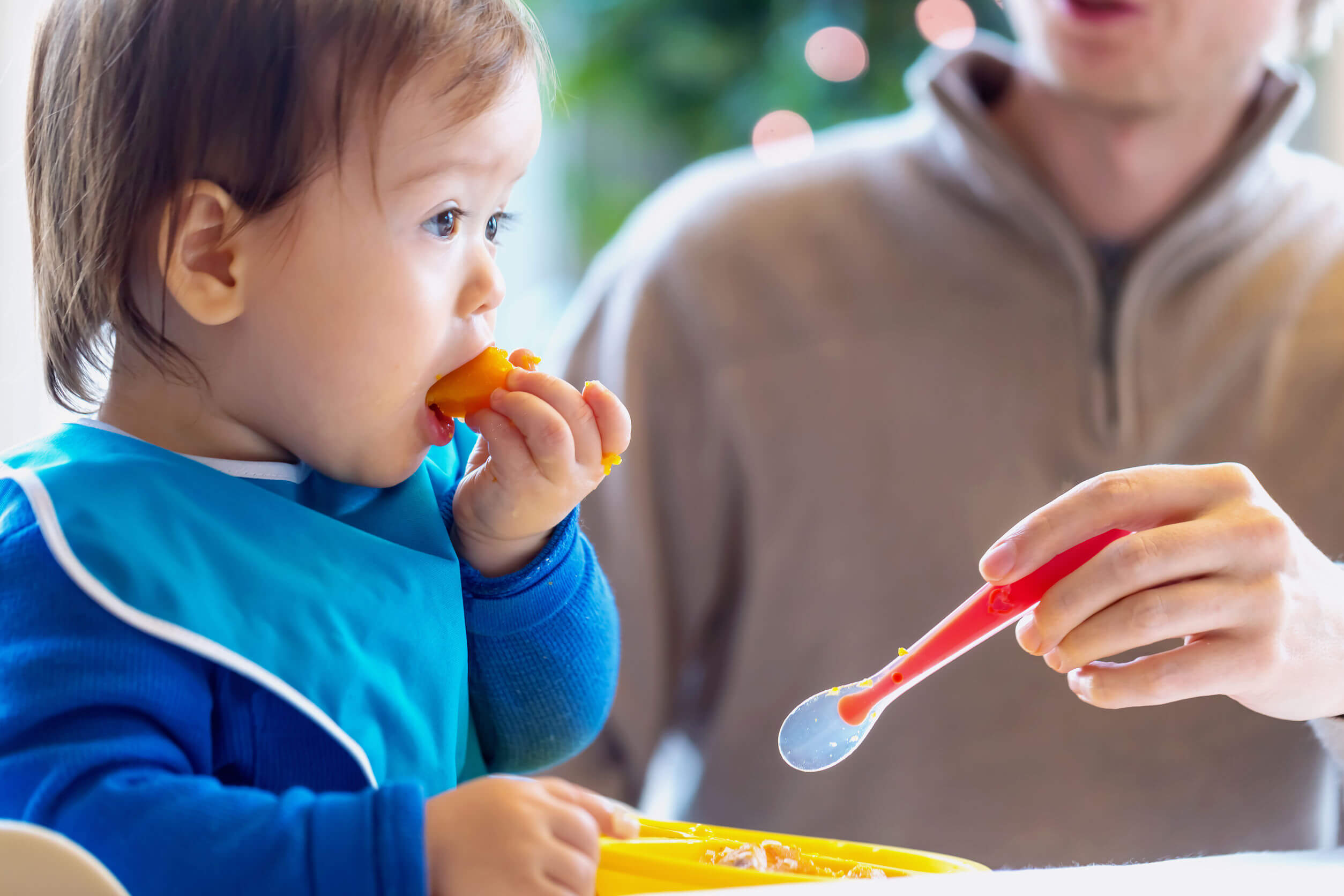4 Exercises for Children to Learn How to Chew

When the little ones begin to eat solid foods, many parents wonder if they’ll know how to do it well. The truth is that children learn how to chew little by little and with practice, although there are some exercises that can help them learn.
Chewing food properly brings many benefits to children. Therefore, it’s important not to delay the incorporation of solid foods and give them a chance to discover new flavors and textures early.
In this article, we’ll tell you all about the importance of stimulating chewing in children and we’ll share exercises to help them. Keep reading!
The importance of chewing in children
From the age of 6 months onwards, it’s important to offer your baby soft, semi-solid, and solid foods progressively.
It’s best to let the child explore the different textures from early stages, because the sooner they have contact with the hardness and consistency of the food, the easier the process will be.
Learning to chew correctly provides the child with multiple benefits. These are the most important ones:
- Decreases the chances of choking: by knowing how to chew, grind, and swallow food, children are less likely to suffer these accidents.
- Promotes proper bone development and strengthening of facial muscles.
- Protects oral health: foods with different textures allow self-cleaning of the teeth. At the same time, purees and milk adhere more to the teeth and favor tooth decay.
- Facilitates digestion: there’s a greater secretion of saliva, the absorption of nutrients is favored, the sensation of satiety is increased, and reflux and gastritis are reduced.
- It reduces anxiety and stress in children, especially at mealtime.

The progression in learning how to chew
Children don’t learn to chew from one day to the next. Rather, it’s a process of acquiring a new skill.
The incorporation of food should also be gradual, but it’s not a good idea to wait too long to give small pieces and varied textures to children. This could cause habituation to purees and a greater risk of rejection of new foods. Especially if the change is close to the age of 2 years and the “no” phase.
An evolution in the types of food offered to the little ones should be followed: Soft textures at the beginning, then semi-solid, solid, and harder ones later. This will stimulate the different sensory receptors in the mouth, help to strengthen the muscles, and practice the movements necessary for this purpose.
Ideally, offer small pieces at first and then move on to larger portions and more complex textures.
Also, mashing foods with a fork instead of processing them allows children to find bits of food in their purees and begin to chew spontaneously.
Tips for children to learn how to chew
Putting some of these tips into practice can help make learning how to chew a pleasurable experience for the whole family, especially the baby.
- Avoid distractions: it’s a good idea not to turn on the TV at mealtime. This way, the whole family can share the moment and the child can concentrate on eating.
- Vary the food: giving your child a taste of different flavors and textures each week can attract and motivate them. Consult your pediatrician about how and what foods to integrate.
- Offer your child what everyone else eats: unless the family menu contains something that the child can’t eat or is too hard or dangerous, it’s best to give your child what everyone else eats. This will encourage them to chew like everyone else.
- Share the moment: having the child share the mealtime sitting at the table with the adults favors his exercise. Exaggerating the movements when chewing will also help him to imitate them.
- Let them eat by themself: exploring the food with their hands and bringing it to their mouth by themself helps them to practice their skills and improve coordination and motor skills. It also promotes their autonomy.
- Be patient: all learning requires time, perseverance, patience, and understanding. It’s essential to avoid moments of tension, challenges, and impositions. And if the child refuses to eat solids, don’t insist. It may not be the right time and you can try again a few weeks later.
- Avoid dangerous foods: don’t give the child foods that, because of their size or hardness, can cause choking. Also, ultra-processed foods and the addition of salt and sugar to foods should be avoided.
When are exercises necessary for children to learn to chew
In most cases, children learn to chew on their own, driven by curiosity and after a lot of practice. Sitting down to eat with them, offering them different consistencies and flavors, and following the advice we’ve given you are usually sufficient strategies.
But other times, children may refuse to eat solid foods or fail to do so. Some anatomical or functional alterations or certain family habits can hinder correct chewing.
If parents notice that there are problems with their child’s feeding, the best thing to do is to consult a pediatrician and get rid of any doubts. Sometimes, referral to a speech therapist may be necessary, as this professional evaluates and intervenes in the chewing functions so that they’re practiced properly.
Observing children during meals helps to detect or suspect if they have any problems with their feeding and if they require specific exercises to learn to chew. These are some of the signs to pay attention to:
- When trying to eat, food falls out of their mouth.
- They move their mouth too much when chewing, as if making faces.
- They use their tongue to mash food.
- The child sucks food instead of chewing it.
- They keep food in their mouth for long periods of time, even several hours.
- They gag at the sight of food.
- They have their mouth open all the time and their tongue out of their mouth.
- They have difficulty sticking out their tongue.
- They show preferences for certain food textures.
- They show difficulties with drinking from straws after 2 years of age.
If a child presents these characteristics, it doesn’t necessarily imply a disorder. But it’s something parents should discuss with the child’s pediatrician.

Exercises for children to learn how to chew
When doing exercises for children to learn to chew, it’s best to do it under the supervision of a speech therapist. Just the same, some simple practices at home can help your child train their oral skills.
Ideally, these exercises should be transformed into moments of play and not become a chore or a burden. Otherwise, they’ll increase the rejection of the activity.
It’s a good idea to find a time to share these activities consciously. Repeating them for a couple of minutes every day or a couple of times a week can have a big impact on your child’s learning.
It’s also advisable to demonstrate and provide a mirror to help them understand what they need to do.
Here are some exercises for children to learn to chew at home.
1. Chewing exercises
Ideally, children should chew their food several times before swallowing it and do so with their mouth closed. This helps to grind the food correctly and to increase the feeling of satiety.
Playing at counting the number of times we chew and reaching 30 will help the child to do it automatically over time. Doing it with them serves as an example and motivates them to incorporate the habit faster.
You can also ask them to concentrate on placing their tongue on the wrinkled area of the palate when chewing, which is behind the central incisors. While in this position, encourage them to chew 10 times only with the left side of the mouth and then 10 times with the right side.
Finally, you can modify the intensity like a game by taking turns. Another option is to create a game of crushing a cookie with the mouth closed and the tongue placed on the rough area of the palate.
2. Tongue exercises
To chew properly, the tongue must be toned and positioned correctly. The following practices can help exercise this muscle:
- Brush their teeth with an electric toothbrush
- Lick ice cream or lollipops out of the mouth
- Dirtying the corners of the child’s mouth with food and asking them to lick themselves clean
- Singing la la la la and clucking the mouth
- Trying to touch their nose with their tongue
3. Exercises for the lips and cheeks
Like the tongue, exercising the lips and cheeks helps the chewing process. To strengthen these structures, you can ask your child to blow kisses in the air, make faces, and spread their lips as far apart as possible.
After 9 months, you can teach your baby to drink with straws or to hold a stick firmly between their lips without using their teeth.
Blowing bubbles, humming songs, and playing whistles are fun activities that also strengthen these structures.
4. Jaw exercises
To strengthen the masticatory muscles and jaw, children can be offered the experience of biting on different objects with different textures. For example, start with baby teethers and then move on to somewhat harder consistencies.
Chewing on objects that vibrate is helpful for some children who are comfortable with this sensation. However, they shouldn’t do it for more than 5 seconds.
Food nets sold in baby products are helpful to keep food on the teeth and use them for chewing. Just fill them with some fruit or food and offer them to your child.

Enjoying the process is key to good learning
Chewing can be easier or more difficult depending on the child. The process involves many muscles and structures in the mouth, which must work in a coordinated manner. And this is achieved with a lot of practice and patience.
The most important thing for your child to be interested in chewing different foods is to not make mealtime a drama. Being constant and patient will help them to go through this learning process with joy and curiosity.
The exercises we detailed above can be of help according to your child’s needs. Keep in mind that each child has their own learning process. Enjoying and accompanying their process with love and respect will help them the most.
When the little ones begin to eat solid foods, many parents wonder if they’ll know how to do it well. The truth is that children learn how to chew little by little and with practice, although there are some exercises that can help them learn.
Chewing food properly brings many benefits to children. Therefore, it’s important not to delay the incorporation of solid foods and give them a chance to discover new flavors and textures early.
In this article, we’ll tell you all about the importance of stimulating chewing in children and we’ll share exercises to help them. Keep reading!
The importance of chewing in children
From the age of 6 months onwards, it’s important to offer your baby soft, semi-solid, and solid foods progressively.
It’s best to let the child explore the different textures from early stages, because the sooner they have contact with the hardness and consistency of the food, the easier the process will be.
Learning to chew correctly provides the child with multiple benefits. These are the most important ones:
- Decreases the chances of choking: by knowing how to chew, grind, and swallow food, children are less likely to suffer these accidents.
- Promotes proper bone development and strengthening of facial muscles.
- Protects oral health: foods with different textures allow self-cleaning of the teeth. At the same time, purees and milk adhere more to the teeth and favor tooth decay.
- Facilitates digestion: there’s a greater secretion of saliva, the absorption of nutrients is favored, the sensation of satiety is increased, and reflux and gastritis are reduced.
- It reduces anxiety and stress in children, especially at mealtime.

The progression in learning how to chew
Children don’t learn to chew from one day to the next. Rather, it’s a process of acquiring a new skill.
The incorporation of food should also be gradual, but it’s not a good idea to wait too long to give small pieces and varied textures to children. This could cause habituation to purees and a greater risk of rejection of new foods. Especially if the change is close to the age of 2 years and the “no” phase.
An evolution in the types of food offered to the little ones should be followed: Soft textures at the beginning, then semi-solid, solid, and harder ones later. This will stimulate the different sensory receptors in the mouth, help to strengthen the muscles, and practice the movements necessary for this purpose.
Ideally, offer small pieces at first and then move on to larger portions and more complex textures.
Also, mashing foods with a fork instead of processing them allows children to find bits of food in their purees and begin to chew spontaneously.
Tips for children to learn how to chew
Putting some of these tips into practice can help make learning how to chew a pleasurable experience for the whole family, especially the baby.
- Avoid distractions: it’s a good idea not to turn on the TV at mealtime. This way, the whole family can share the moment and the child can concentrate on eating.
- Vary the food: giving your child a taste of different flavors and textures each week can attract and motivate them. Consult your pediatrician about how and what foods to integrate.
- Offer your child what everyone else eats: unless the family menu contains something that the child can’t eat or is too hard or dangerous, it’s best to give your child what everyone else eats. This will encourage them to chew like everyone else.
- Share the moment: having the child share the mealtime sitting at the table with the adults favors his exercise. Exaggerating the movements when chewing will also help him to imitate them.
- Let them eat by themself: exploring the food with their hands and bringing it to their mouth by themself helps them to practice their skills and improve coordination and motor skills. It also promotes their autonomy.
- Be patient: all learning requires time, perseverance, patience, and understanding. It’s essential to avoid moments of tension, challenges, and impositions. And if the child refuses to eat solids, don’t insist. It may not be the right time and you can try again a few weeks later.
- Avoid dangerous foods: don’t give the child foods that, because of their size or hardness, can cause choking. Also, ultra-processed foods and the addition of salt and sugar to foods should be avoided.
When are exercises necessary for children to learn to chew
In most cases, children learn to chew on their own, driven by curiosity and after a lot of practice. Sitting down to eat with them, offering them different consistencies and flavors, and following the advice we’ve given you are usually sufficient strategies.
But other times, children may refuse to eat solid foods or fail to do so. Some anatomical or functional alterations or certain family habits can hinder correct chewing.
If parents notice that there are problems with their child’s feeding, the best thing to do is to consult a pediatrician and get rid of any doubts. Sometimes, referral to a speech therapist may be necessary, as this professional evaluates and intervenes in the chewing functions so that they’re practiced properly.
Observing children during meals helps to detect or suspect if they have any problems with their feeding and if they require specific exercises to learn to chew. These are some of the signs to pay attention to:
- When trying to eat, food falls out of their mouth.
- They move their mouth too much when chewing, as if making faces.
- They use their tongue to mash food.
- The child sucks food instead of chewing it.
- They keep food in their mouth for long periods of time, even several hours.
- They gag at the sight of food.
- They have their mouth open all the time and their tongue out of their mouth.
- They have difficulty sticking out their tongue.
- They show preferences for certain food textures.
- They show difficulties with drinking from straws after 2 years of age.
If a child presents these characteristics, it doesn’t necessarily imply a disorder. But it’s something parents should discuss with the child’s pediatrician.

Exercises for children to learn how to chew
When doing exercises for children to learn to chew, it’s best to do it under the supervision of a speech therapist. Just the same, some simple practices at home can help your child train their oral skills.
Ideally, these exercises should be transformed into moments of play and not become a chore or a burden. Otherwise, they’ll increase the rejection of the activity.
It’s a good idea to find a time to share these activities consciously. Repeating them for a couple of minutes every day or a couple of times a week can have a big impact on your child’s learning.
It’s also advisable to demonstrate and provide a mirror to help them understand what they need to do.
Here are some exercises for children to learn to chew at home.
1. Chewing exercises
Ideally, children should chew their food several times before swallowing it and do so with their mouth closed. This helps to grind the food correctly and to increase the feeling of satiety.
Playing at counting the number of times we chew and reaching 30 will help the child to do it automatically over time. Doing it with them serves as an example and motivates them to incorporate the habit faster.
You can also ask them to concentrate on placing their tongue on the wrinkled area of the palate when chewing, which is behind the central incisors. While in this position, encourage them to chew 10 times only with the left side of the mouth and then 10 times with the right side.
Finally, you can modify the intensity like a game by taking turns. Another option is to create a game of crushing a cookie with the mouth closed and the tongue placed on the rough area of the palate.
2. Tongue exercises
To chew properly, the tongue must be toned and positioned correctly. The following practices can help exercise this muscle:
- Brush their teeth with an electric toothbrush
- Lick ice cream or lollipops out of the mouth
- Dirtying the corners of the child’s mouth with food and asking them to lick themselves clean
- Singing la la la la and clucking the mouth
- Trying to touch their nose with their tongue
3. Exercises for the lips and cheeks
Like the tongue, exercising the lips and cheeks helps the chewing process. To strengthen these structures, you can ask your child to blow kisses in the air, make faces, and spread their lips as far apart as possible.
After 9 months, you can teach your baby to drink with straws or to hold a stick firmly between their lips without using their teeth.
Blowing bubbles, humming songs, and playing whistles are fun activities that also strengthen these structures.
4. Jaw exercises
To strengthen the masticatory muscles and jaw, children can be offered the experience of biting on different objects with different textures. For example, start with baby teethers and then move on to somewhat harder consistencies.
Chewing on objects that vibrate is helpful for some children who are comfortable with this sensation. However, they shouldn’t do it for more than 5 seconds.
Food nets sold in baby products are helpful to keep food on the teeth and use them for chewing. Just fill them with some fruit or food and offer them to your child.

Enjoying the process is key to good learning
Chewing can be easier or more difficult depending on the child. The process involves many muscles and structures in the mouth, which must work in a coordinated manner. And this is achieved with a lot of practice and patience.
The most important thing for your child to be interested in chewing different foods is to not make mealtime a drama. Being constant and patient will help them to go through this learning process with joy and curiosity.
The exercises we detailed above can be of help according to your child’s needs. Keep in mind that each child has their own learning process. Enjoying and accompanying their process with love and respect will help them the most.
All cited sources were thoroughly reviewed by our team to ensure their quality, reliability, currency, and validity. The bibliography of this article was considered reliable and of academic or scientific accuracy.
- López Diez, M. (2017). La importancia de las texturas de los alimentos y la masticación: Revisión sistemática.
- Le Révérend, B., Saucy, F., Moser, M., & Loret, C. (2016). Adaptation of mastication mechanics and eating behaviour to small differences in food texture. Physiology & behavior, 165, 136-145.
- Cuadros-Mendoza, C. A., Vichido-Luna, M. A., Montijo-Barrios, E., Zárate-Mondragón, F., Cadena-León, J. F., Cervantes-Bustamante, R., … & Ramírez-Mayans, J. A. (2017). Actualidades en alimentación complementaria. Acta pediátrica de México, 38(3), 182-201.
- Laura, M. M. LA RESPIRACIÓN Y LA DEGLUCIÓN COMO ELEMENTOS FUNDAMENTALES EN LA CONFORMACIÓN DE LAS ARCADAS DENTARIAS.
- DE, C. E. A. TEXTURAS EVOLUTIVAS EN LA INTRODUCCIÓN DE NUEVOS ALIMENTOS.
- Morejón Barrueto, Y., & Acea Vanega, S. (2015). La terapia de alimentación en los problemas del lenguaje en los niños. Medisur, 13(4), 472-474.
- Faigenbaum, A. D., & Bruno, L. E. (2017). A fundamental approach for treating pediatric dynapenia in kids. ACSM’s Health & Fitness Journal, 21(4), 18-24.
- Lazarte, G. C. A., Castro, I. D. R. A., Cántaro, N. Y. M., & Quispe, W. W. C. (2019). PREVALENCIA DE HÁBITOS BUCALES NO FISIOLÓGICOS Y SU RELACION CON LAS MALOCLUSIONES DENTARIAS EN NIÑOS DE 3 A 5 AÑOS DE LA IE INICIAL NUESTROS HÉROES DE LA GUERRA DEL PACÍFICO TACNA-2016. Revista Odontológica Basadrina, 3(1), 20-24.
- LÓPEZ LANDÁZURI, J. Y., & PARRALES PEÑAFIEL, A. J. (2018). MASTICACIÓN Y SU INFLUENCIA EN EL DESARROLLO DE MOVIMIENTOS FONOARTICULATORIOS EN NIÑOS CON INSUFICIENCIA MOTRIZ DE ORIGEN CEREBRAL DE 5 A 7 AÑOS (Doctoral dissertation).
- Kim Kung, R. D. H., & Kelly Hall, R. D. H. Healthy Kids Need Healthy Airways!.
- JIMÉNEZ, V. A., & LENGUAJE, A. Y. TERAPIA MIOFUNCIONAL EN NIÑOS CON DEGLUCIÓN ATÍPICA.
This text is provided for informational purposes only and does not replace consultation with a professional. If in doubt, consult your specialist.








